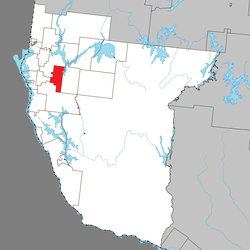Fugèreville
Fugèreville | |
|---|---|
 | |
 Location within Témiscamingue RCM | |
| Coordinates: 47°24′N 79°12′W / 47.400°N 79.200°W[1] | |
| Country | Canada |
| Province | Quebec |
| Region | Abitibi-Témiscamingue |
| RCM | Témiscamingue |
| Settled | 1902 |
| Constituted | February 5, 1904 |
| Government | |
| • Mayor | André Pâquet |
| • Federal riding | Abitibi—Témiscamingue |
| • Prov. riding | Rouyn-Noranda–Témiscamingue |
| Area | |
• Total | 169.15 km2 (65.31 sq mi) |
| • Land | 157.12 km2 (60.66 sq mi) |
| Population (2021)[3] | |
• Total | 326 |
| • Density | 2.1/km2 (5/sq mi) |
| • Pop (2016–21) | |
| • Dwellings | 213 |
| Time zone | UTC−05:00 (EST) |
| • Summer (DST) | UTC−04:00 (EDT) |
| Postal code(s) | |
| Area code | 819 |
| Website | municipalites-du-quebec |
Fugèreville is a municipality in northwestern Quebec, Canada in the Témiscamingue Regional County Municipality.
History
[edit]While logging began in the 1880s, settlement of the area began in 1902, then called Stopping Place and later Pont-Rouge. In 1904, it was incorporated as the United Township Municipality of Laverlochère-et-Baby, after the geographic townships in which it is located, in turn named in honour of Jean-Nicolas Laverlochère and Louis François Georges Baby.[1][4]
In 1912, the Parish of Notre-Dame-du-Mont-Carmel was founded, with Joseph-Armand Fugère as the first parish priest, and in 1914, its post office opened. In 1921, it changed statutes and name to become the Municipality of Fugerville, named after its first priest. In 1969, the spelling was adjusted to Fugèreville.[1][5]
Demographics
[edit]| 2021 | |
|---|---|
| Population | 326 (0.0% from 2016) |
| Land area | 157.12 km2 (60.66 sq mi) |
| Population density | 2.1/km2 (5.4/sq mi) |
| Median age | 47.6 (M: 51.6, F: 43.2) |
| Private dwellings | 213 (total) 148 (occupied) |
| Median household income | $65,500 |
|
|
| |||||||||||||||||||||||||||||||||||||||||||||||||||||||||||||||
| Population counts are not adjusted for boundary changes. Source: Statistics Canada[3][9] | |||||||||||||||||||||||||||||||||||||||||||||||||||||||||||||||||
Mother tongue (2021):[3]
- English as first language: 3.0%
- French as first language: 90.9%
- English and French as first language: 1.5%
- Other as first language: 4.5%
See also
[edit]References
[edit]- ^ a b c "Banque de noms de lieux du Québec: Reference number 24101". toponymie.gouv.qc.ca (in French). Commission de toponymie du Québec.
- ^ a b "Répertoire des municipalités: Geographic code 85055". www.mamh.gouv.qc.ca (in French). Ministère des Affaires municipales et de l'Habitation. Retrieved 2023-12-01.
- ^ a b c d "Fugèreville (Code 2485055) Census Profile". 2021 census. Government of Canada - Statistics Canada. Retrieved 2023-12-01.
- ^ "Banque de noms de lieux du Québec: Baby (canton)". toponymie.gouv.qc.ca (in French). Commission de toponymie du Québec. Retrieved 2023-11-30.
- ^ "Répertoire des entités géopolitiques: Fugèreville (municipalité) 5.2.1904 - ..." www.mairesduquebec.com. Institut généalogique Drouin. Retrieved 30 November 2023.
- ^ "2021 Community Profiles". 2021 Canadian census. Statistics Canada. February 4, 2022. Retrieved 2023-11-28.
- ^ "2006 Community Profiles". 2006 Canadian census. Statistics Canada. August 20, 2019.
- ^ "2001 Community Profiles". 2001 Canadian census. Statistics Canada. July 18, 2021.
- ^ 1996, 2001, 2006, 2011 census
External links
[edit]

